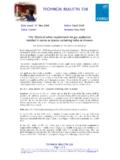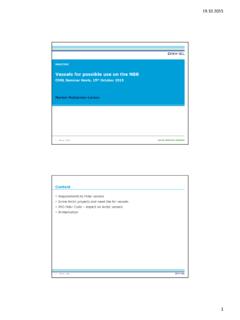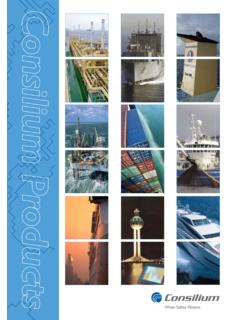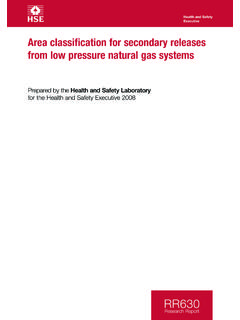Transcription of TECHNICAL BULLETIN 200 - SNIPEF
1 TECHNICAL BULLETIN 200 Page 1 of 5 CORGI has used its best efforts in the production of this information, but makes no warranty about the content and will not be held liable under any circumstances for any direct or indirect damages resulting from the use of this information. This document may not be reproduced in whole or in part without the consent of CORGI other than for personal reference purposes only. TECHNICAL BULLETIN 200 Date issued: 11th June 2007 Author: Jamie Cooper Status: Current Reviewer: 11th June 2008 Title: Room-sealed fanned draught flue systems concealed within voids Introduction With the advent of modern fanned draught flue systems, appliance manufacturers are now able to design longer flue systems, sometimes up to as much as 30 metres in length to enable greater flexibility when siting the appliance. Some building designers are taking the opportunity to site central heating appliances centrally away from external walls within some building developments and then utilising a duct or void, for example a intermediate ceiling void, as a route for the flue system to external air.
2 This is particularly prevalent in multi-storey flats and apartments where space is at a premium. Technically, an intermediate ceiling void is acceptable as a route for a flue system, but building designers, for whatever reason, are often not considering the provision for access to the flue system. Access is needed to enable a gas operative to comply with the requirements of the Gas Safety (Installation and Use) Regulations (GSIUR). These require that flues are examined prior to initial commissioning of the appliance and during routine servicing or maintenance of the appliance. CORGI are aware of this problem and following discussions with representatives from the Health and Safety Executive (HSE), the gas industry and also representatives from the wider building trade, including Local Authority Building Control (LABC) and the NHBC (National House Building Council), it has been agreed that a uniform approach to the situation is required.
3 Therefore the information outlined below will be made available to all of the associated professions and trades involved in the design and construction of buildings to ensure the requirements of legislation, installation standards and appliance manufacturer s installation instructions are consistently applied by all. Current requirements It is a requirement of GSIUR that flues are examined prior to initial commissioning of the appliance and during routine servicing or maintenance of the appliance. This examination needs to verify the effectiveness and general safety of the flue system to ensure the safe continued use of the appliance it serves. With regard to a room-sealed fanned draught flue system, it is necessary to check that: the flue is continuous throughout its length all joints are correctly assembled and are appropriately sealed the flue is adequately supported throughout its length TECHNICAL BULLETIN 200 Page 2 of 5 CORGI has used its best efforts in the production of this information, but makes no warranty about the content and will not be held liable under any circumstances for any direct or indirect damages resulting from the use of this information.
4 This document may not be reproduced in whole or in part without the consent of CORGI other than for personal reference purposes only. To achieve this, it is necessary to be able to visually inspect the flue system throughout its route, both prior to initial commissioning of the appliance and subsequently during routine servicing or maintenance of the appliance. Note 1: It is not intended that additional provision for inspection should be provided for short flue sections connecting an appliance to a terminal and passing directly through an external wall, whether that flue be of a natural or fanned draught flue system design. Note 2: The provisions for checking open flues are outside the scope of this TECHNICAL BULLETIN and are covered by the procedures given in GSIUR and other industry standards including British Standard (BS) 5440-1: 2000 Installation and maintenance of flues and ventilation for gas appliances of rated input not exceeding 70kW net (1st, 2nd and 3rd family gases) Part 1: Specification for the installation and maintenance of flues.
5 Note 3: Consideration should also be given to the ability of replacing the flue system when the appliance becomes obsolete and needs replacing. It is therefore necessary for means of access to be provided at strategic locations so that the flue system can be visually inspected along its route. The means of access should allow for visual inspection to be achieved for the entire length of the flue system, including any separately routed air supply pipe, particularly where there are deviations or joints and supports. It is not envisaged that a means of access is provided at every joint, deviation or support, but it is important that each aspect can at least be visually inspected in some way. Note 4: The means of access to be provided needs to be sufficiently sized to allow a visual inspection to be undertaken. It is not intended that any means of access should be sized to allow physical access to the flue system, for example to carry out maintenance of the system.
6 The location of any means of access should be decided upon through liaison taking place between the property architect/builder/owner and the CORGI registered business installing the flue system/appliance. It is likely that this will need to be done on a property by property or site by site basis, but consideration needs to be given at the design stage. Where access panels are used as a method of gaining visual access to a duct or void, it is important that any fire resisting qualities or acoustic requirements of the building structure are not impaired. It is of course imperative that the appliance manufacturer s installation instructions are strictly adhered to with regard to the maximum length of the flue system, the appropriate flue material, correct jointing methods and the maximum distances between supports. Where the appliance is of the condensing type, the flue system needs to have a uniform gradient back to the appliance throughout its length as specified by the appliance manufacturer.
7 It is important that both flue and appliance maintenance is considered at the earliest planning stages of any construction project. The requirements of the Construction (Design and Management) Regulations (CDM), in particular the requirement for relevant flue information to be contained within the Health and Safety File , may also need to be considered depending on the size of the development. Existing installations without access It is accepted that there will be many installations across the UK that do not meet the minimum requirements outlined above, but the requirement to examine the effectiveness of the room-sealed fanned draught flue system still exists. TECHNICAL BULLETIN 200 Page 3 of 5 CORGI has used its best efforts in the production of this information, but makes no warranty about the content and will not be held liable under any circumstances for any direct or indirect damages resulting from the use of this information.
8 This document may not be reproduced in whole or in part without the consent of CORGI other than for personal reference purposes only. Therefore, when work is carried out on an appliance where access to visually inspect the flue system is not provided to enable an examination of that flue, a risk assessment of the installation should be carried out to determine the action required. In particular, the following points need to be considered when carrying out a risk assessment of the installation: Question the gas user Before commencing any work, through discussions with the gas user, establish the age of the appliance/installation and whether it has been regularly maintained. Also try to establish the route of the flue through the duct or void and whether there have been any previous problems arising from the routing of the flue. It is important that this initial investigation takes place so that the gas operative is aware of the history of the appliance and the installation, which will help in the assessment of the installation.
9 Flue system The flue system should then be assessed to ensure it is of the type specified by the appliance manufacturer, typically either concentric or twin pipe and that the correct materials have been used. Where a concentric flue system is used, it will typically comprise of a metallic outer air duct with either a metallic or plastic inner flue duct. It is important to check that the flue system is connected correctly to the appliance in the manner described by the appliance manufacturer. The flue termination should also be checked to ensure it is installed in accordance with the appliance manufacturer s installation instructions, or if these are not available, BS 5440-1: 2000. For twin pipe flue systems, it is again important to check that the flue is of the type specified by the appliance manufacturer and that the termination is correct.
10 Twin pipe systems will be either metallic or plastic in construction and it is particularly important that the correct material has been used for a plastic flue system and the joints have been made using an approved method. The appliance manufacturer will specify a particular size and grade of plastic as well as the particular method of jointing to be used and these requirements need to be strictly adhered to. Where it is found that the plastic used or jointing method are not as specified by the appliance manufacturer, further investigation will need to be undertaken to ascertain whether it is considered safe to allow the continued use of the gas appliance. Advice will need to be sought from the appliance manufacturer prior to making this decision. The route of the flue should be walked to ensure that there are no stains or discoloration to the material used to construct the duct or void below the flue system, as this may indicate that there is a break or defect in the flue system.










